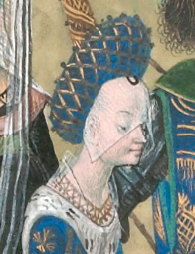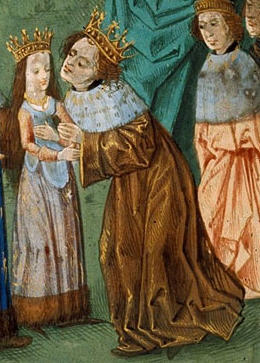Isabella of Valois facts for kids
Quick facts for kids Isabella of Valois |
|
|---|---|
| Duchess of Orléans | |
 |
|
| Queen consort of England | |
| Tenure | 31 October 1396 – 29 September 1399 |
| Coronation | 8 January 1397 |
| Born | 9 November 1389 Paris, France |
| Died | 13 September 1409 (aged 19) Blois, Loir-et-Cher, France |
| Burial | Abbey of Saint Laumer of Blois; reinterred in the Couvent des Célestins, Paris, France |
| Spouse |
|
| Issue | Joan, Duchess of Alençon |
| House | Valois |
| Father | Charles VI of France |
| Mother | Isabeau of Bavaria |
Isabella of Valois (born November 9, 1389 – died September 13, 1409) was a French princess. She became Queen of England when she married Richard II, King of England in 1396. She was queen until 1399. Later, she became Duchess of Orléans after marrying Charles, Duke of Orléans in 1406. She was the daughter of King Charles VI of France.
Contents
Isabella's Early Life
Isabella was born in Paris, France, on November 9, 1389. She was the third child of Charles VI, King of France and his wife, Isabeau of Bavaria. Although she had older siblings, they passed away young. Isabella had many younger brothers and sisters. Seven of them lived past being babies. Some of her younger siblings were born after she had already moved to England for her marriage.
Marriage to King Richard II
In 1396, when Isabella was only six years old, talks began about her marrying Richard II, King of England. King Richard was a widower and 22 years older than her. This marriage was planned to bring peace between France and England.
People talked about Isabella being so young. But King Richard said that her age would change every day. He also thought it was good because he could help shape her into his ideal queen. Isabella told the English visitors that she was happy to be Queen of England. She had been told it would make her a very important lady. She even started practicing for her new role.
King Richard traveled to Paris to meet his young bride. Big celebrations were held there. Then, the royal court and the English guests went to Calais. The wedding ceremony took place on October 31, 1396.
Princess Isabelle, who was crying, wore a blue velvet dress. It was sewn with golden fleur-de-lis and she had a crown of gold and pearls. The Dukes of Berry and Burgundy carried her to Richard’s tent. A group of English ladies, led by the Duchesses of Lancaster and Gloucester, then took her away. Four days later, on November 4, 1396, she was taken to the church of St. Nicholas in Calais. There, Richard married her. She was just five days short of her seventh birthday. Her dolls were even included in her belongings for the marriage.
Isabella Becomes Queen of England
After the wedding, Isabella went to England with her new husband. She moved into Windsor Castle in Berkshire. She had her own royal court. A governess and a chief lady-in-waiting, Madame de Coucy, looked after her. Madame de Coucy was later replaced by Lady Mortimer. Isabella was crowned Queen of England at Westminster Abbey in 1397.
Even though their marriage was arranged for political reasons, Isabella and Richard respected each other. Despite their age difference, they had a good relationship. It was like a father and his adopted daughter, or an uncle and his niece. Richard treated her with kindness, not just as a wife. He saw her more like the daughter he never had.
The king often visited Isabella at Windsor. He treated her with respect and made her and her ladies-in-waiting laugh. He also gave her many gifts and toys. Isabella reportedly enjoyed these visits and looked forward to them.
Changes in Power
By May 1399, Queen Isabella was moved to Portchester Castle for safety. King Richard had gone on a military trip to Ireland. In June, Isabella's uncle, Louis I, Duke of Orléans, took power in France. Her father, King Charles VI, was unwell at the time. Louis decided that peace with England was no longer important. He allowed Henry Bolingbroke, Richard's cousin and rival, to return to England.
Henry's goal was to get back the lands of his father, John of Gaunt, Duke of Lancaster. His father had died earlier that year. King Richard had stopped Henry from inheriting these lands automatically. Many English lords supported Henry. He started a military campaign and took over the country easily. This happened while Richard was still in Ireland.
Edmund of Langley, Duke of York, who was in charge of the kingdom, also joined the rebels. He was an uncle to both Richard and Henry. He first moved Isabella to Wallingford Castle, then to Leeds Castle. On August 19, Richard gave up and was put in prison in London. On October 13, 1399, Henry was crowned king. Isabella was kept at Sonning Bishop's Palace. After a failed attempt to kill Henry IV, Isabella was moved to Essex. She was held under stricter guard at Havering Palace.
Around February 14, 1400, the former king, Richard, died in prison. His death happened under mysterious circumstances. The French court asked for Isabella to be sent back to France. However, Henry IV wanted her to marry his son, Henry of Monmouth. Isabella refused and mourned her late husband. In August 1401, she was finally allowed to return to France. But Henry IV kept her dowry, which was her marriage money.
Isabella Becomes Duchess of Orléans
In 1406, Henry IV again suggested that Isabella marry his son. But the French court refused this idea. Later, in 1420, Henry's son married Isabella's sister, Catherine of Valois.
On June 29, 1406, Isabella, who was 16, married her cousin, Charles, Duke of Orléans. Charles was 11 years old. He became Duke of Orléans in 1407 after his father was killed. Isabella died on September 13, 1409, at the age of 19. She passed away while giving birth. Her daughter, Joan of Valois, survived. Joan later married John II, Duke of Alençon in 1424.
Isabella was buried in Blois, at the Abbey of Saint Laumer. Her body was found there in 1624. Her remains were then moved to the Couvent des Célestins in Paris. This was an important burial place for French royalty.
See also
 In Spanish: Isabel de Francia (1389-1409) para niños
In Spanish: Isabel de Francia (1389-1409) para niños


